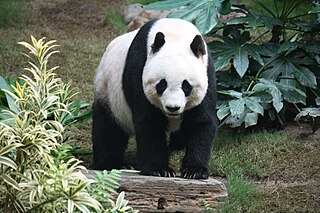The giant panda (Ailuropoda melanoleuca) is a bear native to south central China.
Contents
Giant panda may also refer to:
The giant panda (Ailuropoda melanoleuca) is a bear native to south central China.
Giant panda may also refer to:

The giant panda, also known as the panda bear or simply panda, is a bear species endemic to China. It is characterised by its white coat with black patches around the eyes, ears, legs and shoulders. Its body is rotund; adult individuals weigh 100 to 115 kg and are typically 1.2 to 1.9 m long. It is sexually dimorphic, with males being typically 10 to 20% larger than females. A thumb is visible on its forepaw, which helps in holding bamboo in place for feeding. It has large molar teeth and expanded temporal fossa to meet its dietary requirements. It can digest starch and is mostly herbivorous with a diet consisting almost entirely of bamboo and bamboo shoots.
The giant panda is a bear from the family Ursidae.

Ailuropoda is the only extant genus in the ursid (bear) subfamily Ailuropodinae. It contains one living and one or more fossil species of panda.

The Qinling or Qin Mountains, formerly known as the Nanshan, are a major east–west mountain range in southern Shaanxi Province, China. The mountains mark the divide between the drainage basins of the Yangtze and Yellow River systems, providing a natural boundary between North and South China and support a huge variety of plant and wildlife, some of which is found nowhere else on earth.

An ursid hybrid is an animal with parents from two different species or subspecies of the bear family (Ursidae). Species and subspecies of bear known to have produced offspring with another bear species or subspecies include American black bears, grizzly bears, and polar bears, all of which are members of the genus Ursus. Bears not included in Ursus, such as the giant panda, are expected to be unable to produce hybrids with other bears. The giant panda bear belongs to the genus Ailuropoda.

The Qinling panda, also known as the brown panda, is a subspecies of the giant panda, discovered in 1959, but not recognized as a subspecies until 2005. Besides the nominate subspecies, it is the first giant panda subspecies to be recognized.

Ailuropodinae is a subfamily of Ursidae that contains only one extant species, the giant panda of China. The fossil record of this group has shown that various species of pandas were more widespread across the Holarctic, with species found in places such as Europe, much of Asia, North America and even Africa. The earliest pandas were not unlike other modern bear species in that they had an omnivorous diet but by around 2.4 million years ago, pandas have evolved to be more herbivorous.

Ailurarctos is an extinct genus of panda from the Late Miocene of China, some 8 million years ago.
A. melanoleuca may refer to:
Melanoleuca is a genus of mushrooms in the family Tricholomataceae.

Indocalamus latifolius is an East Asian species of bamboo in the genus Indocalamus.
The giant panda is a bear from the family Ursidae.

Kretzoiarctos is an extinct bear genus from the European Miocene. It consists of Kretzoiarctos beatrix, an ancestor of the extant giant panda.

Ailuropoda baconi is an extinct panda known from cave deposits in South China, Laos, Vietnam, Myanmar, and Thailand from the Late Pleistocene, 750,000 years ago, and was preceded by A. wulingshanensis and A. microta as an ancestor of the giant panda. Very little is known about this animal; however, its latest fossils have been dated to the Late Pleistocene.
Er Shun is a female giant panda, born at the Chongqing Zoo.
Jia Yueyue and Jia Panpan are twin giant pandas born at the Toronto Zoo on 13 October 2015, to mother, Er Shun and father, Da Mao. They were the first giant pandas to be born in Canada, and only the second giant panda twins to survive the neonatal period in North America. Their birth was the result of one of two artificial insemination procedures overnight from 13 to 14 May 2015. The pandas went on public exhibit at the zoo on 12 March 2016. The last day that the giant pandas were viewable at the Toronto Zoo was 18 March 2018. The two pandas have since left Canada and now reside at the Chengdu Research Base of Giant Panda Breeding.
Baylisascaris schroederi is a species of roundworm in the family Ascarididae. It occurs in China and is a parasite of giant pandas. Many wild giant pandas are infected with this parasite.
Ailuropoda wulingshanensis is an extinct species of panda that existed during the Late Pliocene to Early Pleistocene.